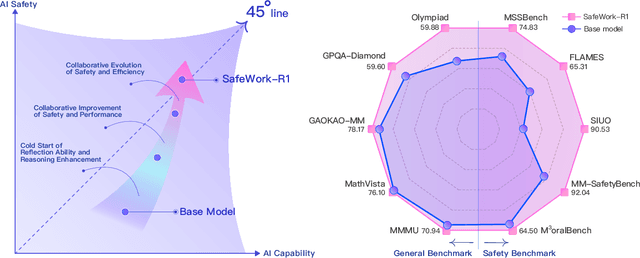Yubo Zhu
The LLM Already Knows: Estimating LLM-Perceived Question Difficulty via Hidden Representations
Sep 16, 2025Abstract:Estimating the difficulty of input questions as perceived by large language models (LLMs) is essential for accurate performance evaluation and adaptive inference. Existing methods typically rely on repeated response sampling, auxiliary models, or fine-tuning the target model itself, which may incur substantial computational costs or compromise generality. In this paper, we propose a novel approach for difficulty estimation that leverages only the hidden representations produced by the target LLM. We model the token-level generation process as a Markov chain and define a value function to estimate the expected output quality given any hidden state. This allows for efficient and accurate difficulty estimation based solely on the initial hidden state, without generating any output tokens. Extensive experiments across both textual and multimodal tasks demonstrate that our method consistently outperforms existing baselines in difficulty estimation. Moreover, we apply our difficulty estimates to guide adaptive reasoning strategies, including Self-Consistency, Best-of-N, and Self-Refine, achieving higher inference efficiency with fewer generated tokens.
SafeWork-R1: Coevolving Safety and Intelligence under the AI-45$^{\circ}$ Law
Jul 24, 2025



Abstract:We introduce SafeWork-R1, a cutting-edge multimodal reasoning model that demonstrates the coevolution of capabilities and safety. It is developed by our proposed SafeLadder framework, which incorporates large-scale, progressive, safety-oriented reinforcement learning post-training, supported by a suite of multi-principled verifiers. Unlike previous alignment methods such as RLHF that simply learn human preferences, SafeLadder enables SafeWork-R1 to develop intrinsic safety reasoning and self-reflection abilities, giving rise to safety `aha' moments. Notably, SafeWork-R1 achieves an average improvement of $46.54\%$ over its base model Qwen2.5-VL-72B on safety-related benchmarks without compromising general capabilities, and delivers state-of-the-art safety performance compared to leading proprietary models such as GPT-4.1 and Claude Opus 4. To further bolster its reliability, we implement two distinct inference-time intervention methods and a deliberative search mechanism, enforcing step-level verification. Finally, we further develop SafeWork-R1-InternVL3-78B, SafeWork-R1-DeepSeek-70B, and SafeWork-R1-Qwen2.5VL-7B. All resulting models demonstrate that safety and capability can co-evolve synergistically, highlighting the generalizability of our framework in building robust, reliable, and trustworthy general-purpose AI.
Video Summarization using Denoising Diffusion Probabilistic Model
Dec 12, 2024



Abstract:Video summarization aims to eliminate visual redundancy while retaining key parts of video to construct concise and comprehensive synopses. Most existing methods use discriminative models to predict the importance scores of video frames. However, these methods are susceptible to annotation inconsistency caused by the inherent subjectivity of different annotators when annotating the same video. In this paper, we introduce a generative framework for video summarization that learns how to generate summaries from a probability distribution perspective, effectively reducing the interference of subjective annotation noise. Specifically, we propose a novel diffusion summarization method based on the Denoising Diffusion Probabilistic Model (DDPM), which learns the probability distribution of training data through noise prediction, and generates summaries by iterative denoising. Our method is more resistant to subjective annotation noise, and is less prone to overfitting the training data than discriminative methods, with strong generalization ability. Moreover, to facilitate training DDPM with limited data, we employ an unsupervised video summarization model to implement the earlier denoising process. Extensive experiments on various datasets (TVSum, SumMe, and FPVSum) demonstrate the effectiveness of our method.
Detecting Dataset Abuse in Fine-Tuning Stable Diffusion Models for Text-to-Image Synthesis
Sep 27, 2024



Abstract:Text-to-image synthesis has become highly popular for generating realistic and stylized images, often requiring fine-tuning generative models with domain-specific datasets for specialized tasks. However, these valuable datasets face risks of unauthorized usage and unapproved sharing, compromising the rights of the owners. In this paper, we address the issue of dataset abuse during the fine-tuning of Stable Diffusion models for text-to-image synthesis. We present a dataset watermarking framework designed to detect unauthorized usage and trace data leaks. The framework employs two key strategies across multiple watermarking schemes and is effective for large-scale dataset authorization. Extensive experiments demonstrate the framework's effectiveness, minimal impact on the dataset (only 2% of the data required to be modified for high detection accuracy), and ability to trace data leaks. Our results also highlight the robustness and transferability of the framework, proving its practical applicability in detecting dataset abuse.
 Add to Chrome
Add to Chrome Add to Firefox
Add to Firefox Add to Edge
Add to Edge